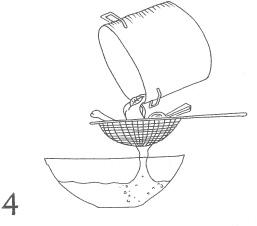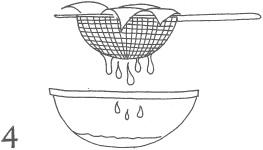The Thrifty Cookbook: 476 Ways to Eat Well With Leftovers (11 page)
Read The Thrifty Cookbook: 476 Ways to Eat Well With Leftovers Online
Authors: Kate Colquhoun
Tags: #General, #Cooking

BOOK: The Thrifty Cookbook: 476 Ways to Eat Well With Leftovers
6.08Mb size Format: txt, pdf, ePub
Bring slowly to the boil and then simmer very gently, uncovered, for about 2 hours. The stock will be clearer if you skim off the froth from the top with a slotted spoon from time to time.
When the stock is ready, strain it. Discard the bones, allow to cool, then refrigerate.
If there is any fat, it will rise to the surface and harden. I lift it off with a spoon and throw it out.
Store the stock in a covered bowl or plastic box in the fridge, or freeze in plastic boxes, bowls or soup bags. (To save space, you can boil the stock until reduced by about two-thirds. When you come to use it, just bring it back to its original volume by adding water.)
Once the stock has been strained and cooled, and any fat on the surface has been removed (see above), return the stock to a clean pan and bring to a slow simmer.
In a small bowl, lightly whisk an egg white (for up to 1.5 litres liquid; use 2 egg whites for more liquid).
Add this to the simmering stock and swirl with a spoon. The egg will turn white almost immediately. Barely simmer for a couple of minutes and lift the egg out with a slotted spoon, discarding it.
Strain the stock through a sieve lined with a square of kitchen paper, then cool and refrigerate, or freeze as usual.
As with meat stock, you can use the heads and bones left over from whole cooked fish or bring home bones from the fishmonger’s if you have asked them to fillet your fish for you (unlike raw meat bones, these do not need roasting before use).
Fish stock is invaluable for use in fish pies, risottos and fish soup. Follow the instructions for Meat Stock on the previous pages, using fish carcasses, heads and tails from white fish (avoid oily fish), or shells from prawns, crabs, lobsters, etc, but simmer the stock for just 20-30 minutes. If you’ve got any prawn or langoustine shells, toast them first in a frying pan (without oil) before adding them to the stock.
Vegetable stock makes the lightest of broths, and is also ideal for risottos, stews, soups, etc. Follow the instructions for Meat Stock on the previous pages, using either the last few vegetables from the fridge, roughly chopped, or clean vegetable peelings, or even the pods left over from shelling fresh peas or broad beans (but avoid starchy vegetables like potatoes and parsnips). The stock needs to simmer for just 20-30 minutes.

Other books
The Stocking Was Hung by Tara Sivec
Save Me by Lisa Scottoline
Thomas Covenant 8 - The Fatal Revenant by Stephen R. Donaldson
The Sergeant Major's Daughter by Sheila Walsh
Lucky Love by Nicola Marsh
Gambling on the Bodyguard by Sarah Ballance
Deadly Election by Lindsey Davis
Death Of A Sad Face (A Serafina Florio Mystery) by Susan Russo Anderson
Nine Fingers by Thom August









